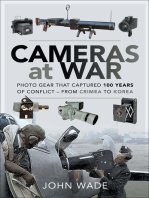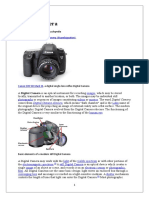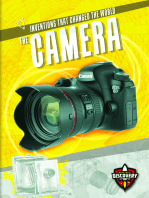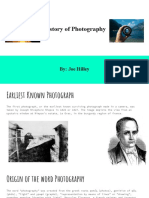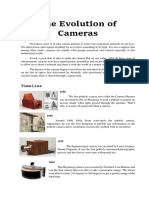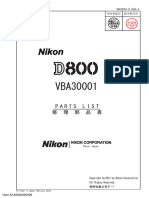0 ratings0% found this document useful (0 votes)
167 viewsHistory of Photography by Con
History of Photography by Con
Uploaded by
Datulna Benito Mamaluba Jr.LLEGE OF CRIMINOLOGY
COLLEGE OF CRIMINOLOGY
I COURSE NUMBER : CRIMINOLOGY 1 I COURSE TITLE : INTRODUCTION TO CRIMINOLOGY
I COURSE DESCRIPTION :
An overview of the study of crimes, criminals and victims; factors that precipitate crime repressions and control of crime ; criminal etiology causes or predisposing factors and producing elements of crime; analysis of the social, psychological, physical, biological and personality traits that makes a particular act a crime, thus making the person a criminal/victims; the role of the pale, the probation and parole officers, and social workers in the criminal justice system.
IV COURSE PRE-REQUISITE : None
IV COURSE CREDIT : 3 units
I COURSE NUMBER : DEF TAC 1 I COURSE TITLE : KARATEDO / AIKIDO / JUDO / ARNIS / BOXING
I COURSE DESCRIPTION :
An overview on the different techniques in karatido, aikido, judo, arnis and boxing wherein student should learn in order for them to defend themselves specially in a critical situation. This involves learning the different correct patterns – movements in their form, sequence, blocks, punches and kicks must be done for the correct position. Proper energy management will ensure the martial artists able to complete martial arts with consistent power and effective technique. The martial artists should trained the students on how to breath correctly in order to overcome obstacles such as fear, anxiety, stress and physical exertions. The origins of aikido, karatedo, judo, arnis and boxing, Although some karate techniques also involve grappling and holding, it should not be confused with judo, which does not permit striking or kicking one’s opponent.
IV COURSE PRE-REQUISITE : None
IV COURSE CREDIT : 2 units
I COURSE NUMBER : S & SM 1 I COURSE TITLE : INTRODUCTION TO SECURITY & SAFETY MGNT.
I COURSE DESCRIPTION :
It involves the study of all types of security and safety management on the different properties. The importance of security in an institution and to every human being. A combination of security training and experience which provides the desirable knowledge skills and abilities to our students. A security work requires attention to detail, accuracy consistency, and high level of accountability, sensitivity and mature judgment in the application of specialized knowledge gained through considerable security training. Security ensures personnels property, files, maintains and updates policies.
IV COURSE PRE-REQUISITE : None
IV COURSE CREDIT : 3 units
I COURSE NUMBER : LEA 1 I DESCRITIVE TITLE : PHILIPPINE CRIMINAL JUSTICE SYSTEM
I COURSE DESCRIPTION :
This course on criminal Justice System is an interdisciplinary study of the police, the prosecution, the court, correction and the community in the Philippine and American setting. It prevents to students, the future law officers, the linkages of its five pillars (police, prosecution, court, correction and the community) and their interactions is bringing about a well-balanced action for justice to the criminal.
Obviously, the study is tailor made for the protection of the offender who commit crime, but at the same time protecting the some violator from the violation of their rights by criminal justice agents- the police. This study depicts the police as the prime mover of the system, the criminal is the superstar whereas, the victim is the forgotten man.
IV COURSE PRE-REQUISITE : None
IV COURSE CREDIT : 3 units
I COURSE NUMBER : DEF TAC 2 I DESCRITIVE TITLE : DEFENSIVE DRIVING
I COURSE DESCRIPTION :
An overview of this subject involves the discussion on the different factors that cause vehicle crashes. Provides seven essential strategies for driving defensively, stresses importance of driving defensively through familiarity of vehicle, awareness of vehicle, coexistence on other drivers and used of seatbelt. Emphasizes on the importance of controlling the distractions while driving, and shows the potential consequences while
Copyright:
© All Rights Reserved
Available Formats
Download as PPT, PDF, TXT or read online from Scribd
History of Photography by Con
History of Photography by Con
Uploaded by
Datulna Benito Mamaluba Jr.0 ratings0% found this document useful (0 votes)
167 views22 pagesLLEGE OF CRIMINOLOGY
COLLEGE OF CRIMINOLOGY
I COURSE NUMBER : CRIMINOLOGY 1 I COURSE TITLE : INTRODUCTION TO CRIMINOLOGY
I COURSE DESCRIPTION :
An overview of the study of crimes, criminals and victims; factors that precipitate crime repressions and control of crime ; criminal etiology causes or predisposing factors and producing elements of crime; analysis of the social, psychological, physical, biological and personality traits that makes a particular act a crime, thus making the person a criminal/victims; the role of the pale, the probation and parole officers, and social workers in the criminal justice system.
IV COURSE PRE-REQUISITE : None
IV COURSE CREDIT : 3 units
I COURSE NUMBER : DEF TAC 1 I COURSE TITLE : KARATEDO / AIKIDO / JUDO / ARNIS / BOXING
I COURSE DESCRIPTION :
An overview on the different techniques in karatido, aikido, judo, arnis and boxing wherein student should learn in order for them to defend themselves specially in a critical situation. This involves learning the different correct patterns – movements in their form, sequence, blocks, punches and kicks must be done for the correct position. Proper energy management will ensure the martial artists able to complete martial arts with consistent power and effective technique. The martial artists should trained the students on how to breath correctly in order to overcome obstacles such as fear, anxiety, stress and physical exertions. The origins of aikido, karatedo, judo, arnis and boxing, Although some karate techniques also involve grappling and holding, it should not be confused with judo, which does not permit striking or kicking one’s opponent.
IV COURSE PRE-REQUISITE : None
IV COURSE CREDIT : 2 units
I COURSE NUMBER : S & SM 1 I COURSE TITLE : INTRODUCTION TO SECURITY & SAFETY MGNT.
I COURSE DESCRIPTION :
It involves the study of all types of security and safety management on the different properties. The importance of security in an institution and to every human being. A combination of security training and experience which provides the desirable knowledge skills and abilities to our students. A security work requires attention to detail, accuracy consistency, and high level of accountability, sensitivity and mature judgment in the application of specialized knowledge gained through considerable security training. Security ensures personnels property, files, maintains and updates policies.
IV COURSE PRE-REQUISITE : None
IV COURSE CREDIT : 3 units
I COURSE NUMBER : LEA 1 I DESCRITIVE TITLE : PHILIPPINE CRIMINAL JUSTICE SYSTEM
I COURSE DESCRIPTION :
This course on criminal Justice System is an interdisciplinary study of the police, the prosecution, the court, correction and the community in the Philippine and American setting. It prevents to students, the future law officers, the linkages of its five pillars (police, prosecution, court, correction and the community) and their interactions is bringing about a well-balanced action for justice to the criminal.
Obviously, the study is tailor made for the protection of the offender who commit crime, but at the same time protecting the some violator from the violation of their rights by criminal justice agents- the police. This study depicts the police as the prime mover of the system, the criminal is the superstar whereas, the victim is the forgotten man.
IV COURSE PRE-REQUISITE : None
IV COURSE CREDIT : 3 units
I COURSE NUMBER : DEF TAC 2 I DESCRITIVE TITLE : DEFENSIVE DRIVING
I COURSE DESCRIPTION :
An overview of this subject involves the discussion on the different factors that cause vehicle crashes. Provides seven essential strategies for driving defensively, stresses importance of driving defensively through familiarity of vehicle, awareness of vehicle, coexistence on other drivers and used of seatbelt. Emphasizes on the importance of controlling the distractions while driving, and shows the potential consequences while
Original Title
History of Photography by con
Copyright
© © All Rights Reserved
Available Formats
PPT, PDF, TXT or read online from Scribd
Share this document
Did you find this document useful?
Is this content inappropriate?
LLEGE OF CRIMINOLOGY
COLLEGE OF CRIMINOLOGY
I COURSE NUMBER : CRIMINOLOGY 1 I COURSE TITLE : INTRODUCTION TO CRIMINOLOGY
I COURSE DESCRIPTION :
An overview of the study of crimes, criminals and victims; factors that precipitate crime repressions and control of crime ; criminal etiology causes or predisposing factors and producing elements of crime; analysis of the social, psychological, physical, biological and personality traits that makes a particular act a crime, thus making the person a criminal/victims; the role of the pale, the probation and parole officers, and social workers in the criminal justice system.
IV COURSE PRE-REQUISITE : None
IV COURSE CREDIT : 3 units
I COURSE NUMBER : DEF TAC 1 I COURSE TITLE : KARATEDO / AIKIDO / JUDO / ARNIS / BOXING
I COURSE DESCRIPTION :
An overview on the different techniques in karatido, aikido, judo, arnis and boxing wherein student should learn in order for them to defend themselves specially in a critical situation. This involves learning the different correct patterns – movements in their form, sequence, blocks, punches and kicks must be done for the correct position. Proper energy management will ensure the martial artists able to complete martial arts with consistent power and effective technique. The martial artists should trained the students on how to breath correctly in order to overcome obstacles such as fear, anxiety, stress and physical exertions. The origins of aikido, karatedo, judo, arnis and boxing, Although some karate techniques also involve grappling and holding, it should not be confused with judo, which does not permit striking or kicking one’s opponent.
IV COURSE PRE-REQUISITE : None
IV COURSE CREDIT : 2 units
I COURSE NUMBER : S & SM 1 I COURSE TITLE : INTRODUCTION TO SECURITY & SAFETY MGNT.
I COURSE DESCRIPTION :
It involves the study of all types of security and safety management on the different properties. The importance of security in an institution and to every human being. A combination of security training and experience which provides the desirable knowledge skills and abilities to our students. A security work requires attention to detail, accuracy consistency, and high level of accountability, sensitivity and mature judgment in the application of specialized knowledge gained through considerable security training. Security ensures personnels property, files, maintains and updates policies.
IV COURSE PRE-REQUISITE : None
IV COURSE CREDIT : 3 units
I COURSE NUMBER : LEA 1 I DESCRITIVE TITLE : PHILIPPINE CRIMINAL JUSTICE SYSTEM
I COURSE DESCRIPTION :
This course on criminal Justice System is an interdisciplinary study of the police, the prosecution, the court, correction and the community in the Philippine and American setting. It prevents to students, the future law officers, the linkages of its five pillars (police, prosecution, court, correction and the community) and their interactions is bringing about a well-balanced action for justice to the criminal.
Obviously, the study is tailor made for the protection of the offender who commit crime, but at the same time protecting the some violator from the violation of their rights by criminal justice agents- the police. This study depicts the police as the prime mover of the system, the criminal is the superstar whereas, the victim is the forgotten man.
IV COURSE PRE-REQUISITE : None
IV COURSE CREDIT : 3 units
I COURSE NUMBER : DEF TAC 2 I DESCRITIVE TITLE : DEFENSIVE DRIVING
I COURSE DESCRIPTION :
An overview of this subject involves the discussion on the different factors that cause vehicle crashes. Provides seven essential strategies for driving defensively, stresses importance of driving defensively through familiarity of vehicle, awareness of vehicle, coexistence on other drivers and used of seatbelt. Emphasizes on the importance of controlling the distractions while driving, and shows the potential consequences while
Copyright:
© All Rights Reserved
Available Formats
Download as PPT, PDF, TXT or read online from Scribd
Download as ppt, pdf, or txt
0 ratings0% found this document useful (0 votes)
167 views22 pagesHistory of Photography by Con
History of Photography by Con
Uploaded by
Datulna Benito Mamaluba Jr.LLEGE OF CRIMINOLOGY
COLLEGE OF CRIMINOLOGY
I COURSE NUMBER : CRIMINOLOGY 1 I COURSE TITLE : INTRODUCTION TO CRIMINOLOGY
I COURSE DESCRIPTION :
An overview of the study of crimes, criminals and victims; factors that precipitate crime repressions and control of crime ; criminal etiology causes or predisposing factors and producing elements of crime; analysis of the social, psychological, physical, biological and personality traits that makes a particular act a crime, thus making the person a criminal/victims; the role of the pale, the probation and parole officers, and social workers in the criminal justice system.
IV COURSE PRE-REQUISITE : None
IV COURSE CREDIT : 3 units
I COURSE NUMBER : DEF TAC 1 I COURSE TITLE : KARATEDO / AIKIDO / JUDO / ARNIS / BOXING
I COURSE DESCRIPTION :
An overview on the different techniques in karatido, aikido, judo, arnis and boxing wherein student should learn in order for them to defend themselves specially in a critical situation. This involves learning the different correct patterns – movements in their form, sequence, blocks, punches and kicks must be done for the correct position. Proper energy management will ensure the martial artists able to complete martial arts with consistent power and effective technique. The martial artists should trained the students on how to breath correctly in order to overcome obstacles such as fear, anxiety, stress and physical exertions. The origins of aikido, karatedo, judo, arnis and boxing, Although some karate techniques also involve grappling and holding, it should not be confused with judo, which does not permit striking or kicking one’s opponent.
IV COURSE PRE-REQUISITE : None
IV COURSE CREDIT : 2 units
I COURSE NUMBER : S & SM 1 I COURSE TITLE : INTRODUCTION TO SECURITY & SAFETY MGNT.
I COURSE DESCRIPTION :
It involves the study of all types of security and safety management on the different properties. The importance of security in an institution and to every human being. A combination of security training and experience which provides the desirable knowledge skills and abilities to our students. A security work requires attention to detail, accuracy consistency, and high level of accountability, sensitivity and mature judgment in the application of specialized knowledge gained through considerable security training. Security ensures personnels property, files, maintains and updates policies.
IV COURSE PRE-REQUISITE : None
IV COURSE CREDIT : 3 units
I COURSE NUMBER : LEA 1 I DESCRITIVE TITLE : PHILIPPINE CRIMINAL JUSTICE SYSTEM
I COURSE DESCRIPTION :
This course on criminal Justice System is an interdisciplinary study of the police, the prosecution, the court, correction and the community in the Philippine and American setting. It prevents to students, the future law officers, the linkages of its five pillars (police, prosecution, court, correction and the community) and their interactions is bringing about a well-balanced action for justice to the criminal.
Obviously, the study is tailor made for the protection of the offender who commit crime, but at the same time protecting the some violator from the violation of their rights by criminal justice agents- the police. This study depicts the police as the prime mover of the system, the criminal is the superstar whereas, the victim is the forgotten man.
IV COURSE PRE-REQUISITE : None
IV COURSE CREDIT : 3 units
I COURSE NUMBER : DEF TAC 2 I DESCRITIVE TITLE : DEFENSIVE DRIVING
I COURSE DESCRIPTION :
An overview of this subject involves the discussion on the different factors that cause vehicle crashes. Provides seven essential strategies for driving defensively, stresses importance of driving defensively through familiarity of vehicle, awareness of vehicle, coexistence on other drivers and used of seatbelt. Emphasizes on the importance of controlling the distractions while driving, and shows the potential consequences while
Copyright:
© All Rights Reserved
Available Formats
Download as PPT, PDF, TXT or read online from Scribd
Download as ppt, pdf, or txt
You are on page 1of 22
History Of Photography
Pinhole Camera to Digital Photography
History
Lesson Objectives
Define photography
Learn scientific principles behind
photography
Learn about numerous innovators and
their processes and ideas
Photography Morphology
Comes from 2 ancient Greek words:
Photo = light
Graph = draw or write
Photography = light writing
Scientific Principles
Camera obscura = darkroom
Leonardo da Vinci drawing;1519
Not permanent
Chemicals
Silver chloride turns
-dark under exposure
Daguerreotypy
Daguerre
Partners with Niepce
photographic plates
Processing
30 minutes
One photograph
Stereoscopic Photography
3D image
Special camera with two lenses
2 simultaneous photographs
2 different views
Birth of motion pictures
Leland Stanford unwittingly
started a chain of events
that contributed to the
development of motion
pictures. To settle a wager
regarding the position of a
trotting horse's legs, he sent
for Eadweard Muybridge, a
British photographer who
had recently been
acclaimed for his
photographs of Yosemite.
Although Muybridge made history when he arranged 12 cameras alongside a race
track. Each was fitted with a shutter working at a speed he claimed to be "less than the
two-thousandth part of a second." Strings attached to electric switches were stretched
across the track; the horse, rushing past, breasted the strings and broke them, one
after the other; and a series of negatives were made.
Though the photographs were hardly more than silhouettes, they
clearly showed that the feet of the horse were all off the ground at
one phase of the gallop. Moreover, to the surprise of the world, the
feet were bunched together under the belly.
The Scientific American printed eighteen drawings from Muybridge's photographs
on the first page of its October 19, 1878 issue. Readers were invited to paste the
pictures on strips and to view them in the popular toy known as the zoetrope,
A precursor of motion pictures. It was an open drum with slits in its side,
mounted horizontally on a spindle so it could be twirled. Drawings showing
successive phases of action placed inside the drum and viewed through the
slits were seen one after the other, so quickly that the images merged in the
mind to produce the illusion of motion.
Film Medium
slide (positive) or
print (negative)
film speed (ISO-
International
Standards
Organization) or
ASA(American
Standards
Association) or DIN
(German Institute for
Standardization)
Film brand (Kodak,
Fuji, Agfa, and
Polariod)
Film Processing
Dektol (developer)
Stop bath (prevents
contamination of fixer)
Fixer (removes active silver to
make image permanent)
Film Cameras
Box Cameras
Folding
Cameras
Large Format
View Cameras
Twin Lens
Reflex (TLR)
Rangefinder
Single Lens
Reflex (SLR)
Mr. George Eastman started the Kodak Camera Company. He worked
hard to develop a camera that everybody could afford to buy. He did it in
1900. It was the Kodak Brownie box roll-film camera. It cost $1.00. Now
everyone could take photographs, not just professional photographers.
Folding Cameras
The early folding cameras were
compact amateur view cameras, At
the end of the 19th century the first
renowned strut folding cameras were
designed, for No. 3A Autographic
Kodak Junior.
Its lens assembly needs to be pulled
out along the rails on its opened
hinged front door.
The leaf shutter has a small lever for
firing and maybe another for cocking
Film is advanced with a key or knob;
one stops winding when the new
number appears in a red window on
the back.
viewfinder is a swivelling brilliant
finder attached to the front of the
lens.
Large Format Cameras
The press camera is still in
wide use in and among
fine art photographers
Advances in film
technology, notably finer
film grain, have obviated
the need for large-format
cameras for most press
assignments, however. In
news photography, the
press camera has been
largely supplanted by the
smaller formats of 120 film
and 35mm film, and more
recently by digital cameras.
35 mm Rangefinder Cameras
Rugged reliability: made
back in the days when
cameras had more metal
than plastic
Rangefinder focusing still
can't be beat for speed
and accuracy
Mechanical Copal and
Compur shutters on these
classics (works with a
dead battery!)
Fast, extremely sharp
lenses (works in low
lighting conditions)
35 mm Single Lens Reflex
Single-lens reflex
(SLR) camera is a
camera that typically
uses a semi-automatic
moving mirror system
Photographer see exactly
what will be captured by
the film
As opposed to pre-SLR
cameras where the view
through the viewfinder
could be significantly
different from what was
captured on film.
Digital Cameras: Early Samples
Since the mid-1970s, Kodak has
invented several solid-state
image sensors
In 1986, Kodak scientists
invented the world's first
megapixel sensor, capable of
recording 1.4 million pixels that
could produce a 5x7-inch digital
photo-quality print.
Mavica was a brand of Sony
cameras which used removable
disks as the main recording
media. In August, 1981, Sony
released the Sony Mavica
(Magnetic Video Camera)
electronic still camera, the first
commercial electronic camera.
Digital Cameras
Digital technology
the wave of the future.
Most people these
days have a digital cell
phones.
Many people have
digital cameras.
The new cell phones
that take digital
pictures.
Digital Computer
technology
Digital Image Processing
Solid State Memory
Adobe Photoshop
PowerPoint
Fastone Viewer
(free!)
Summary History Of Photography
Capturing Images through Film and Solid
state devices
Film Chemical Processing
Digital image Processing through Computer
Software
Cameras from the Pinhole Camera to
Todays Modern SLR Digital Devices
Future?
You might also like
- History of The CameraDocument7 pagesHistory of The CameraChristian D. OrbeNo ratings yet
- CH 3 Worksheet 2 (Autosaved)Document4 pagesCH 3 Worksheet 2 (Autosaved)Jawad HussainNo ratings yet
- 1820 Camera Obscura Essentially A Portable Box With ADocument4 pages1820 Camera Obscura Essentially A Portable Box With Aapi-26169128100% (1)
- History of PhotographyDocument14 pagesHistory of Photographyapi-435337057No ratings yet
- Cameras at War: Photo Gear that Captured 100 Years of Conflict - From Crimea to KoreaFrom EverandCameras at War: Photo Gear that Captured 100 Years of Conflict - From Crimea to KoreaNo ratings yet
- Katalog Sinar enDocument67 pagesKatalog Sinar enpaolinop100% (1)
- History of Photography: Pinhole Camera To Digital PhotographyDocument22 pagesHistory of Photography: Pinhole Camera To Digital PhotographycoffeemintNo ratings yet
- EVOLUTION OF THE CAMERADocument14 pagesEVOLUTION OF THE CAMERAkryzzia angelaNo ratings yet
- CS 12digicamDocument9 pagesCS 12digicamJefferson DampilNo ratings yet
- Timeline - The Evolution of The CameraDocument11 pagesTimeline - The Evolution of The CameraDineshChotraniNo ratings yet
- Digital Camera: From Wikipedia, The Free Encyclopedia For Other Uses, SeeDocument12 pagesDigital Camera: From Wikipedia, The Free Encyclopedia For Other Uses, SeeBoobalan RNo ratings yet
- By-Akshat Pandit Class - 7B Roll No - 19Document16 pagesBy-Akshat Pandit Class - 7B Roll No - 19Akshat PanditNo ratings yet
- Camera Parts and FunctionsDocument25 pagesCamera Parts and FunctionsjcecilNo ratings yet
- Ancient CamerasDocument7 pagesAncient CameraspoornimaNo ratings yet
- A Brief History of Photography and The CameraDocument5 pagesA Brief History of Photography and The CameraReen BlueNo ratings yet
- Parts of Camera and Their FunctionsDocument12 pagesParts of Camera and Their Functionsloidslight67% (9)
- ScriptDocument3 pagesScriptapi-643236424No ratings yet
- The History of The CameraDocument2 pagesThe History of The CameraAndy WijayaNo ratings yet
- Intro To Digital PhotographyDocument20 pagesIntro To Digital Photographyvictoranurukem081No ratings yet
- History of PhotographyDocument21 pagesHistory of Photographyselisalim03No ratings yet
- How The Polaroid Camera Influenced The World of PhotographyDocument21 pagesHow The Polaroid Camera Influenced The World of PhotographyPanos Andronopoulos100% (1)
- PhotographyDocument33 pagesPhotographyvenjoven01No ratings yet
- Essay On 16mm FilmDocument7 pagesEssay On 16mm FilmPanos Andronopoulos100% (1)
- The Evolution of CameraDocument6 pagesThe Evolution of CameraBirsan LaurentiuNo ratings yet
- Presentation 1Document14 pagesPresentation 1api-386197084No ratings yet
- Evolutia Camerei FOTODocument17 pagesEvolutia Camerei FOTOBrandy RomanNo ratings yet
- History of Photography Timeline AssignmentDocument14 pagesHistory of Photography Timeline Assignmentapi-442289303No ratings yet
- By-Akshat Pandit Class - 7B Roll No - 19Document16 pagesBy-Akshat Pandit Class - 7B Roll No - 19ddevNo ratings yet
- The Evolution of CameraDocument5 pagesThe Evolution of CameraCDT. NICDAO PRINCE ALREI G.No ratings yet
- History of The CameraDocument13 pagesHistory of The CameraNassarQadarNo ratings yet
- The History of CameraDocument3 pagesThe History of Cameratemidayojessica24No ratings yet
- Types of CameraDocument16 pagesTypes of CameraOsman Gumanti Ahmad AlbabNo ratings yet
- Forensic PhotographyDocument69 pagesForensic PhotographyMary Rose Baluran100% (2)
- History of The CameraDocument20 pagesHistory of The CameraAircraft DesignNo ratings yet
- Basic To Advanced PhotographyDocument32 pagesBasic To Advanced PhotographyPranav GuptaNo ratings yet
- Photography AssignmentDocument10 pagesPhotography AssignmentjoeNo ratings yet
- Kodak Essential Reference GuideDocument216 pagesKodak Essential Reference GuideTheWolfGmorkNo ratings yet
- The Essential Reference Guide For FilmmakersDocument216 pagesThe Essential Reference Guide For FilmmakersvamcareerNo ratings yet
- Goldene Kamera: From Wikipedia, The Free EncyclopediaDocument12 pagesGoldene Kamera: From Wikipedia, The Free Encyclopediaarif2108No ratings yet
- History of Photography Timeline AssignmentDocument14 pagesHistory of Photography Timeline Assignmentapi-358369052100% (1)
- History of PhotographyDocument5 pagesHistory of PhotographyAbdullah FahmiNo ratings yet
- Evolution of CameraDocument10 pagesEvolution of CameraAkshi DixitNo ratings yet
- CHAPTER 7 PHOTOGRAPHY DeograciasDocument16 pagesCHAPTER 7 PHOTOGRAPHY DeograciasKitch Irish Mancile100% (1)
- The Essential Reference Guide For Filmmakers Author KodakDocument216 pagesThe Essential Reference Guide For Filmmakers Author Kodakkenatejoycelyne37No ratings yet
- AdithyaRaj ASD23BVAM043Document8 pagesAdithyaRaj ASD23BVAM043adithyawizNo ratings yet
- MCD401 Handouts PDFDocument387 pagesMCD401 Handouts PDFSuban KhanNo ratings yet
- 5Th Century B.C.: An Example of How A Pinhole Camera WorksDocument9 pages5Th Century B.C.: An Example of How A Pinhole Camera WorksMiles Kilometer CentimeterNo ratings yet
- History of Photography ASSESSMENT BY ANGEL PDF VERDocument18 pagesHistory of Photography ASSESSMENT BY ANGEL PDF VERfarmeed33No ratings yet
- The Time Line of Camera by RodDocument11 pagesThe Time Line of Camera by RodLemuel Lagasca Razalan IVNo ratings yet
- Photography: What It Is, How It Works and How It Was InventedDocument20 pagesPhotography: What It Is, How It Works and How It Was Inventedhoangmy0106No ratings yet
- Art of PhotographyDocument31 pagesArt of PhotographyIvanof VioletaNo ratings yet
- The Evolution of CamerasDocument3 pagesThe Evolution of CamerasSVTKhsia100% (1)
- Difference Between Digital Single-Lens Reflex Camera and A Smartphone Camera - Assessment BriefDocument23 pagesDifference Between Digital Single-Lens Reflex Camera and A Smartphone Camera - Assessment BriefJalina Joyce CasañaNo ratings yet
- Alternative Photography EssayDocument6 pagesAlternative Photography Essayjerry.galle4607No ratings yet
- An Overview of The Industry: A Study On The Promotional Strategies of FujifilmDocument53 pagesAn Overview of The Industry: A Study On The Promotional Strategies of FujifilmAnjal NandananNo ratings yet
- English Term 1 Sample PaperDocument4 pagesEnglish Term 1 Sample Papersreeya arlagadda100% (1)
- The History of The CameraDocument3 pagesThe History of The CameraZen ChenNo ratings yet
- What I Wish Everyone Knew AboutDocument8 pagesWhat I Wish Everyone Knew AboutOppo UdoyNo ratings yet
- Photography Techniques (Elementary)Document90 pagesPhotography Techniques (Elementary)Truc Nguyen100% (2)
- Mohd Jamri Mohd Naji Matric No: 0821617 CCPS 3101 Section 3 Lecturer: Bro. AdamDocument11 pagesMohd Jamri Mohd Naji Matric No: 0821617 CCPS 3101 Section 3 Lecturer: Bro. Adamjam-fanNo ratings yet
- Guidelines and Mechanics of Biggest Loser Arkcons EditionDocument1 pageGuidelines and Mechanics of Biggest Loser Arkcons EditionDatulna Benito Mamaluba Jr.No ratings yet
- Statement of No Ongoing Project (RBParcon) MAFARDocument1 pageStatement of No Ongoing Project (RBParcon) MAFARDatulna Benito Mamaluba Jr.No ratings yet
- 60th Birthday ProgramDocument3 pages60th Birthday ProgramDatulna Benito Mamaluba Jr.No ratings yet
- Motivation Towards Teamwork: Datulna B. Mamaluba, JR., RcrimDocument20 pagesMotivation Towards Teamwork: Datulna B. Mamaluba, JR., RcrimDatulna Benito Mamaluba Jr.No ratings yet
- What Is A Research Journal?: Edited by A Professional Proofread Submitting Your PaperDocument3 pagesWhat Is A Research Journal?: Edited by A Professional Proofread Submitting Your PaperDatulna Benito Mamaluba Jr.No ratings yet
- Human Resource Management and Development'S Main Functio NDocument8 pagesHuman Resource Management and Development'S Main Functio NDatulna Benito Mamaluba Jr.No ratings yet
- Total Ban On Smoking PolicyDocument2 pagesTotal Ban On Smoking PolicyDatulna Benito Mamaluba Jr.No ratings yet
- JANUARY 2020: Sun Mon Tue Wed Thu Fri SatDocument12 pagesJANUARY 2020: Sun Mon Tue Wed Thu Fri SatDatulna Benito Mamaluba Jr.No ratings yet
- 2020 CalendarDocument12 pages2020 CalendarDatulna Benito Mamaluba Jr.No ratings yet
- Handbook On Workers Statutory Monetary Benefits 2020 EditionDocument80 pagesHandbook On Workers Statutory Monetary Benefits 2020 EditionDatulna Benito Mamaluba Jr.No ratings yet
- January 2020Document12 pagesJanuary 2020Datulna Benito Mamaluba Jr.No ratings yet
- October 2020: Sunday Monday Tuesday Wednesday Thursday Friday SaturdayDocument1 pageOctober 2020: Sunday Monday Tuesday Wednesday Thursday Friday SaturdayDatulna Benito Mamaluba Jr.No ratings yet
- September 2020: Sunday Monday Tuesday Wednesday Thursday Friday SaturdayDocument1 pageSeptember 2020: Sunday Monday Tuesday Wednesday Thursday Friday SaturdayDatulna Benito Mamaluba Jr.No ratings yet
- Notes:: New Year'S Day MlkingdayDocument12 pagesNotes:: New Year'S Day MlkingdayDatulna Benito Mamaluba Jr.No ratings yet
- November 2020: Sunday Monday Tuesday Wednesday Thursday Friday SaturdayDocument1 pageNovember 2020: Sunday Monday Tuesday Wednesday Thursday Friday SaturdayDatulna Benito Mamaluba Jr.No ratings yet
- August 2020: Sunday Monday Tuesday Wednesday Thursday Friday SaturdayDocument1 pageAugust 2020: Sunday Monday Tuesday Wednesday Thursday Friday SaturdayDatulna Benito Mamaluba Jr.No ratings yet
- April 2020: Sunday Monday Tuesday Wednesday Thursday Friday SaturdayDocument1 pageApril 2020: Sunday Monday Tuesday Wednesday Thursday Friday SaturdayDatulna Benito Mamaluba Jr.No ratings yet
- December 2020: Sunday Monday Tuesday Wednesday Thursday Friday SaturdayDocument1 pageDecember 2020: Sunday Monday Tuesday Wednesday Thursday Friday SaturdayDatulna Benito Mamaluba Jr.No ratings yet
- June 2020: Sunday Monday Tuesday Wednesday Thursday Friday SaturdayDocument1 pageJune 2020: Sunday Monday Tuesday Wednesday Thursday Friday SaturdayDatulna Benito Mamaluba Jr.No ratings yet
- January 2020: Sunday Monday Tuesday Wednesday Thursday Friday SaturdayDocument1 pageJanuary 2020: Sunday Monday Tuesday Wednesday Thursday Friday SaturdayDatulna Benito Mamaluba Jr.No ratings yet
- May 2020 PDFDocument1 pageMay 2020 PDFDatulna Benito Mamaluba Jr.No ratings yet
- October 2019 PDFDocument1 pageOctober 2019 PDFDatulna Benito Mamaluba Jr.No ratings yet
- December 2019: Sunday Monday Tuesday Wednesday Thursday Friday SaturdayDocument1 pageDecember 2019: Sunday Monday Tuesday Wednesday Thursday Friday SaturdayDatulna Benito Mamaluba Jr.No ratings yet
- November 2019: Sunday Monday Tuesday Wednesday Thursday Friday SaturdayDocument1 pageNovember 2019: Sunday Monday Tuesday Wednesday Thursday Friday SaturdayDatulna Benito Mamaluba Jr.No ratings yet
- Sunday Monday Tuesday Wednesday Thursday Friday SaturdayDocument1 pageSunday Monday Tuesday Wednesday Thursday Friday SaturdayDatulna Benito Mamaluba Jr.No ratings yet
- October 2019: Sunday Monday Tuesday Wednesday Thursday Friday SaturdayDocument1 pageOctober 2019: Sunday Monday Tuesday Wednesday Thursday Friday SaturdayDatulna Benito Mamaluba Jr.No ratings yet
- April 2019: Sunday Monday Tuesday Wednesday Thursday Friday SaturdayDocument1 pageApril 2019: Sunday Monday Tuesday Wednesday Thursday Friday SaturdayDatulna Benito Mamaluba Jr.No ratings yet
- June 2019: Sunday Monday Tuesday Wednesday Thursday Friday SaturdayDocument1 pageJune 2019: Sunday Monday Tuesday Wednesday Thursday Friday SaturdayDatulna Benito Mamaluba Jr.No ratings yet
- July 2019: Sunday Monday Tuesday Wednesday Thursday Friday SaturdayDocument1 pageJuly 2019: Sunday Monday Tuesday Wednesday Thursday Friday SaturdayDatulna Benito Mamaluba Jr.No ratings yet
- Sunday Monday Tuesday Wednesday Thursday Friday SaturdayDocument1 pageSunday Monday Tuesday Wednesday Thursday Friday SaturdayDatulna Benito Mamaluba Jr.No ratings yet
- Digital Linear Tape: HistoryDocument5 pagesDigital Linear Tape: HistoryvsraneyNo ratings yet
- GL4000 Spy Glasses Camera User Manual Multiple Languages 201909Document24 pagesGL4000 Spy Glasses Camera User Manual Multiple Languages 201909Daniel PenninckNo ratings yet
- Linhof CamerasDocument9 pagesLinhof CameraskukimakNo ratings yet
- Lista de Precios PromocionDocument1 pageLista de Precios PromocionMarlon LarcoNo ratings yet
- EF-FX1 Compatible List Model: Canon Lens To Fuji Camera Adapter Ring Adapter Model: EF-FX1 Adapter Firmware Version: (Updated) V2.29Document3 pagesEF-FX1 Compatible List Model: Canon Lens To Fuji Camera Adapter Ring Adapter Model: EF-FX1 Adapter Firmware Version: (Updated) V2.29Adrian BerindeiNo ratings yet
- Methods of Data StorageDocument2 pagesMethods of Data StorageGugathasan Dharsan100% (1)
- Gtifs - Is - I: Joruicmnufl, LDocument40 pagesGtifs - Is - I: Joruicmnufl, LAugustoAzeredoSilvaNo ratings yet
- Harddrive ClippingDocument17 pagesHarddrive ClippingBasu Dev AryalNo ratings yet
- History of Photography Timeline-2020Document2 pagesHistory of Photography Timeline-2020api-525060335No ratings yet
- Sewa Kamera Lampung: Jalan Beringin, Labuhan Ratu, Kota Bandar LampungDocument7 pagesSewa Kamera Lampung: Jalan Beringin, Labuhan Ratu, Kota Bandar LampungDeni TijowNo ratings yet
- Assignment:-2: Magnetic Tapes Floppy Disc CD - Rom Blue Ray TechnologyDocument15 pagesAssignment:-2: Magnetic Tapes Floppy Disc CD - Rom Blue Ray TechnologyRevan GaikwadNo ratings yet
- Digital CamerasDocument4 pagesDigital CamerasJoshua JapitanNo ratings yet
- Toshiba W-02 Class10 Card Compatibility List: TM TMDocument9 pagesToshiba W-02 Class10 Card Compatibility List: TM TMRicky FloresNo ratings yet
- 5 - Pandas and GroupbyDocument1 page5 - Pandas and GroupbyJagadeesh ReddyNo ratings yet
- Camera ComparisonDocument2 pagesCamera ComparisondeepakmukhiNo ratings yet
- CanonLegriaHFS200 Quick GuideDocument9 pagesCanonLegriaHFS200 Quick GuideHynek BuresNo ratings yet
- Computer Memory: TypesDocument3 pagesComputer Memory: TypesRam Krishna AdhikariNo ratings yet
- 6.solid State Storage MediaDocument5 pages6.solid State Storage MediaSam ManNo ratings yet
- Canon R Vs Sony A7 III Detailed ComparisonDocument18 pagesCanon R Vs Sony A7 III Detailed ComparisonTi SiNo ratings yet
- Types of Storage Devices: Size Smaller LargerDocument2 pagesTypes of Storage Devices: Size Smaller LargerSuhana Singh100% (1)
- Promo Wise Net Lite - SetDocument1 pagePromo Wise Net Lite - SetMarco Antonio RubinaNo ratings yet
- Chapter 4 - Secondary StorageDocument45 pagesChapter 4 - Secondary StorageNur Amira NadiaNo ratings yet
- Contoh PRF - CameraDocument1 pageContoh PRF - CameraEarlytta NuitaNo ratings yet
- Grade 10 Art 2nd MidtermDocument40 pagesGrade 10 Art 2nd MidtermFeri FranchescaNo ratings yet
- Storage Devices and MediaDocument8 pagesStorage Devices and Mediataha imranNo ratings yet
- 8e6b3766fe75170d Nikon d800 Parts ListDocument41 pages8e6b3766fe75170d Nikon d800 Parts ListGerman Tirado MontoyaNo ratings yet
- Price ListDocument94 pagesPrice ListOxana StamatiiNo ratings yet
- Chapter - 3: Video Cassette RecorderDocument21 pagesChapter - 3: Video Cassette Recorderapolloroka50% (2)




